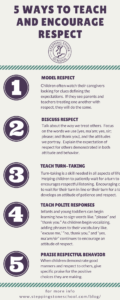5 Ways to Teach and Encourage Respect
In preparation for this month’s Kindness and Empathy™ focus, I asked my four-year-old about Respect. He pondered for several moments and then provided an exasperated reply, “I don’t know; what is it?” I found myself challenged to come up with the words to describe this character trait and fell back on examples of when we have seen respect displayed through the actions of others.

Respect is one character trait you may easily recognize when you see it and just as easily identify when it is absent.
Partnering with you to encourage this valuable character trait, our Stepping Stone School professionals will work diligently to provide children with opportunities to discuss and participate in activities promoting respect for others. The following are some ways we can work together to teach and encourage respect:
- Model Respect. Children often watch their caregivers looking for clues defining the expectations. If they see parents and teachers treating one another with respect, they will do the same.
- Discuss Respect. As children grow, talk about the way we treat others. Focus on the words we use (yes, ma’am; yes, sir; please; and thank you), and the attitudes we portray. Explain the expectation of respect for others demonstrated in both attitude and behavior.
- Teach Turn-Taking. Turn-taking is a skill needed in all aspects of life. Helping children to patiently wait for a turn to speak encourages respectful listening. Encouraging children to wait for their turn in line or their turn for a toy develops an attitude of patience and respect.
- Teach Polite Responses. Infants and young toddlers can begin learning how to use ASL sign language to communicate words like, “please” and “thank you.” At Stepping Stone School, we begin teaching these ASL signs in our infant classrooms and continue to build upon these important phrases throughout the years. As children begin vocalizing, adding phrases to their vocabulary like, “excuse me,” “no, thank you,” and “yes, ma’am/sir” continues to encourage an attitude of respect.
- Praise Respectful Behavior: When children demonstrate good manners and respect to others, give specific praise for the positive choices they are making.
Time and consistency together with our intentional teaching efforts will teach children this valuable character trait. Hopefully, next time I ask my child about respect, he will be able to provide me with a definition of his own.

Resources:
Ask Dr. Sears. (2013, August 23). “7 Ways to Teach Your Child Manners.” Retrieved on February 18, 2016 from http://www.askdrsears.com/topics/parenting/discipline-behavior/morals-manners/7-ways-teach-your-child-manners
Kear, N. (2010). “The Return of Respect!” Retrieved on February 18, 2016 from www.parents.com/toddlers-preschoolers/development/manners/the-return-of-respect/
Silverman, R. (2008, April 12). “10 Tips on Teaching Respect to Children: You can’t get it if you don’t give it!” Retrieved on February 18, 2016 from http://drrobynsilverman.com/parenting-tips/10-tips-on-teaching-respect-to-children-you-cant-get-it-if-you-dont-give-it/
VanClay, M. (2007). “The respectful child: How to teach respect.” Retrieved on February 18, 2016 from http://www.babycenter.com/0_the-respectful-child-how-to-teach-respect_64686.bc